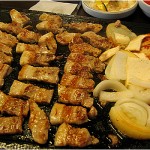Have you wondered what would be the appropriate way to order food in Korean? The waitstaff of many Korean restaurants in New York City are well-equipped to serve English speaking customers. However, if you can make requests in Korean with the utmost politeness, your dining experience will be more pleasant and enjoyable.
Do you want to learn how to pronounce all the phrases in this article? Please follow the attached link Flashcards and Pronunciation which has all the phrases in flashcards!
Let’s begin with a simple situation that you and your friend are in a restaurant. Most of the places provide menus to customers once they are seated, but for the purpose of practicing Korean in this article, let’s assume that you need to call the waitstaff to ask for a menu.
English (You): Excuse me. May I have a menu please?
Korean (You): 여기요. 메뉴 좀 주시겠어요?
1) Saying ‘여기요’ aloud is the most effective way to gain a server’s attention and it is equivalent with ‘Excuse me’ or ‘here’ in English.
2) Every time you add ‘좀’ in a sentence, the expression becomes more polite and softer. When making requests in Korean the term means ‘please.’
After screening through the menu, you pick out two dishes, for instance, soybean stew and porkbelly barbecue. Your server comes to your table and asks what you would like to order.
English (Server): What would you like to have?
Korean (Server): 무엇을(뭘) 드시겠습니까?
Your response is:
English (You): I would like to order a soybean stew and two portions of pork belly barbeque.
Korean (You): 된장찌게 일인분하고 삼겹살 이인분 주세요.
The above are common phrases you get to exchange with staff in a Korean restaurant when ordering food. When a person who takes your order says 무엇을 드시겠습니까? or 뭘 드시겠습니까? both sentences mean what would you like to order/have? in the same level of formality and politeness.
There are 3 points I would like to emphasize:
1) Did you catch words ‘일인분, 이인분’ in the second sentence? These indicate specifically the number of portions of food that are being ordered and are counting units, such as ‘인분’ comes after a number (i.e. 일, 이, 삼,사,오,육,칠,팔,구,십 etc). Let’s practice!
- One(a) helping of bbq - 일인분 바베큐
- Two helpings of bbq - 이인분 바베큐
2) When listing two nouns in one sentence, ‘and’ is a commonly used connector and in Korean you simply follow the formula N 하고 N . Here are few examples:
- apple and banana - 사과 하고 바나나
- water and beer - 물 하고 맥주
3) Lastly, ‘N 주세요’ is a very useful phrase to know when you want to request N. See in below:
- N: water - 물 주세요
- N: apple - 사과 주세요
How are we doing so far? I hope you and your friend are enjoying flavorful Korean food. Now, we are going to end the meal by asking for the check.
English (You): Check please.
Korean (You): 계산서 주세요.
You may need to try to grab a server’s attention by using ‘여기요’ again. Assuming that you have his/her attention, I would recommend you to utilize ‘N 주세요.’ Check or bill in Korean is 계산서, and saying 계산서 주세요 is a polite and formal way.
You can also ask this phrase in the form of a question:,
계산서 주시겠어요?
Thank you for reading this article about how to order food in Korean. We hope that you continue to learn the Korean language either through other resources on our website, taking a class for learning Korean, or just continuing your self study. Stay tuned for further articles on Korean!
Flashcards and Pronunciation of this Article: